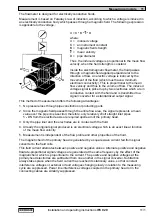
Installation and operating instructions
IFC 020
E2
Keyword
Section No. Fct. No.
S
S = Status output
2.4, 4.4, 5.8
1.06, 1.07, 3.07
Safety isolation
2.1
Setting level
4.1-4.4
1.00 et seq.,
2.00 et seq.,
3.00 et seq.
Signal converter IFC 020
– accuracies
10.3
– cable A
1.3.1
– changeover, power supply
8.2
– connecting & operating points
4.2, 8.9
– connection to power
1.2
– functional checks
7.1-7.6,
– fuses, power
8.5
– mounting location
1.1
– nameplates
10.5
– operator control
4.1-4.3
– power consumption
10.4
– printed circuit boards
8.9
– spare parts
9
– technical data
10.1-10.4
Simulator GS 8A
7.6
SMU = low-flow cutoff
4.4, 5.3
1.03
Software
6.2
Spare parts, see order numbers
9
Status output S
2.4, 4.4, 5.8
1.06, 1.07, 3.07
T
T = time constant
5.2
1.02
Technical data
– accuracies
10.3
– dimensions & weights
10.2
– signal converter IFC 020
10.1-10.4
Terminals B1/B2
2.1, 2.6, 5.16
3.07 (1.06, 1.07)
Tests, see functional checks
7.1 et seq.
Time constant (T)
5.2
1.02
Totalizer (internal electronic)
2.3, 5.7
1.06, 3.07
Trip point
2.4, 2.6, 5.8
1.06, 1.07
Troubleshooting, see
functional checks
7.1 et seq.
U
Units for
– display
4.4, 5.4
1.04
– flow
4.4, 5.1
1.01
– P
4.4, 5.7
1.06
User-defined unit
4.4, 5.13
3.05
V
v = flow velocity
4.4, 5.1
3.02
VDE standards
page 0/4
W
Weights, see dimensions
10.2
Z
Zero check (adjustment)
7.1
3.03
ZD, intermediate connection box
1.3.5, 10.2
Keyword
Section No. Fct. No.
M
Magnetic field frequency
4.4 + 5.11
3.02
Magnetic sensors
4.2
Main menu column
4.1
Main menus
4.1 to 4.3
1.00, 2.00, 3.00
Mass flow measurement,
see user defined unit
4.4, 5.13
Measuring principle
11
Menu
4.1, 4.4
Meter size (DN)
4.4, 5.12
3.02
N
Numerical format, display
5.4, 5.5
1.04
O
Option = optional equipment
6.2, 10.4
Order numbers
9
Outputs
– characteristics
5.15
– connection diagrams
2.6
– setting
4.4
– – I
5.6
1.05
– – P
5.7, 5.16
1.06, 3.07
– – S
5.8, 5.16
1.06, 1.07, 3.07
– voltage stable when
measuring tube empty
6.3
Overflow, display
5.5
1.04
Overranged
– I (current output)
2.2, 2.6, 5.6, 5.8 1.06, 1.07
– P (pulse output)
2.3, 2.6, 5.7, 5.8 1.06, 1.07
Overvoltage class
2.1
P
P = pulse output
2.4, 4.4, 5.7
1.06
PCB = printed circuit boards
8.9
PC software
6.2
PE = protective conductor
1.2
Power supply (= line voltage)
– changeover
8.2
– connection
2.1, 10.4
– consumption
10.4
– failure
4.5, 7.4
– frequency
1.2, 10.4
– voltage
1.2, 10.4
Primary constant, see GK
4.4, 5.12
3.02
Primary head
– constant, see GK
4.4, 5.12
3.02
– simulator GS 8A
7.6
– testing
7.5
Primary simulator, see GS 8A
7.6
Printed circuit boards, see PCB
8.9
Program organization
4.1
Programming = input
4.1-4.3
Programming mode, entry into
4.1-4-3
Protective conductor PE
1.2
Pulsating flow
6.4, 6.5, 6.6
3.06
Pulse output P
2.3, 4.4, 5.7
1.06
Pulse width
4.4, 5.7
1.06
Pulses per unit time
4.4, 5.7
1.06
Pulses per unit volume
4.4, 5.7
1.06
Q
Q = flow rate
4.4, 5.1
1.01, 3.02
Q
100%
= full-scale range
4.4, 5.1
1.01, 3.02
R
R = reverse flow
4.4, 5.14
1.04-1.07
Range change
– automatic
2.5, 2.6,
1.06, 1.07
5.8, 5.18
– external
2.5, 2.6,
1.06, 1.07
5.9, 5.18
Range setting
4.4, 5.1, 5.12
1.01, 3.02
Replacement
– electronic unit
8.7
– power fuses
8.1
Reset totalizers
4.6
Reverse flow (R)
4.4, 5.14
1.04-1.07
Revert to
– functions column
4.1-4.3
– main menu column
4.1-4.3
– measuring mode
4.1-4.3
– submenu column
4.1-4.3
RS 232 interface
6.2


































